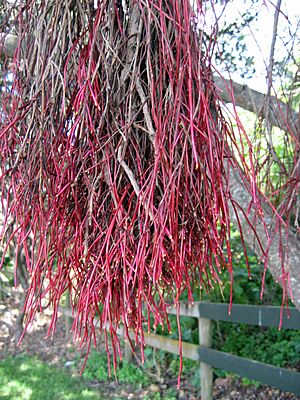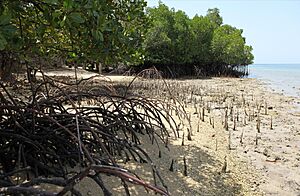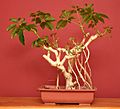Aerial root facts for kids
An aerial root is a special kind of root that grows above the ground, not buried in the soil. Many different plants have these unique roots. They can help plants in several ways, like giving them support, helping them breathe, or even finding food.
Contents
How Aerial Roots Help Plants
Aerial roots are amazing because they can do many different jobs for a plant. Let's explore some of their main functions.
Roots for Support
Some plants use their aerial roots to hold onto things or to stand up tall.
- Climbing Roots: Plants like ivy have small aerial roots that act like tiny grappling hooks. They help the ivy cling tightly to structures such as stone walls or other trees, allowing the plant to climb high.
- Prop Roots: The Banyan tree, sometimes called a "strangler fig," grows thick aerial roots downwards from its branches. These roots eventually reach the forest floor and grow into strong, woody trunks. Over time, these new trunks can become so big that they might even surround and cause the original "host" tree to die. They provide extra support for the banyan's wide canopy.
Roots for Breathing
Some plants live in very wet places where the soil is full of water and has very little air.
- Breathing Roots (Pneumatophores): To get the air they need, these plants grow special aerial roots that stick up out of the water or mud. Black mangroves are a great example. Their roots, called pneumatophores, act like snorkels, allowing the plant to "breathe" oxygen from the air.
Roots for Getting Nutrients
Some plants are like tiny food thieves, using aerial roots to get what they need from other plants.
- Parasitic Roots: A parasite is a plant that lives on or in another plant and gets its food from it. Some parasitic plants, like mistletoe, grow aerial roots that dig into their host plant. These roots then steal water and nutrients from the host, helping the mistletoe to grow.
Roots for Reproduction
Some plants use their aerial roots to make new plants.
- Runner Roots: Certain plants have above-ground stems that grow horizontally, often called "runners." Along these runners, little new plants with their own leaves and roots can start to grow. Eventually, these new plantlets can drop off and grow into completely new plants that are exact copies (clones) of the parent plant. Good examples are strawberries and the spider plant.
Images for kids
-
The Grey Mangrove (Avicennia marina)'s pneumatophorous aerial roots.
-
A large Banyan tree in Fort Myers, Florida.
See also
 In Spanish: Raíz aérea para niños
In Spanish: Raíz aérea para niños










